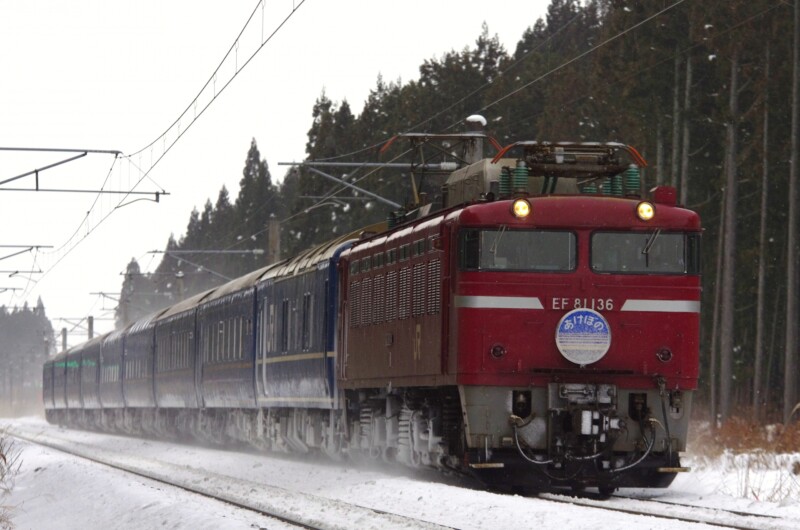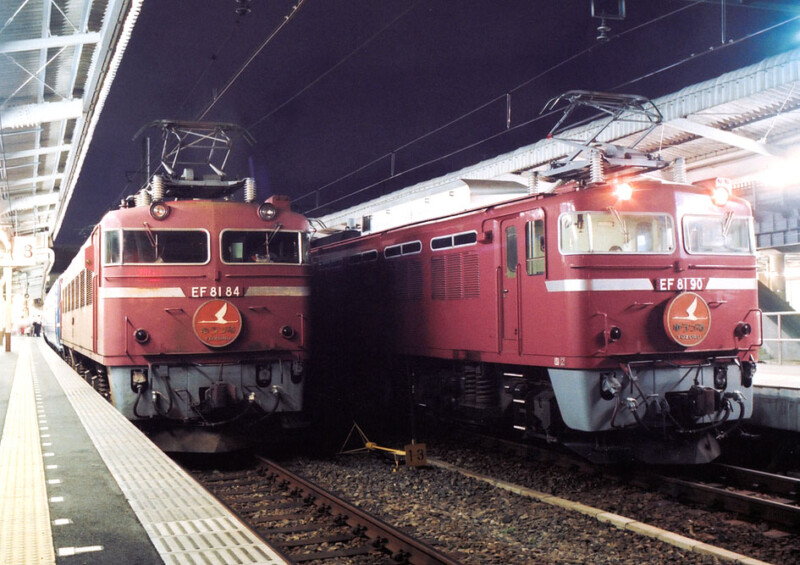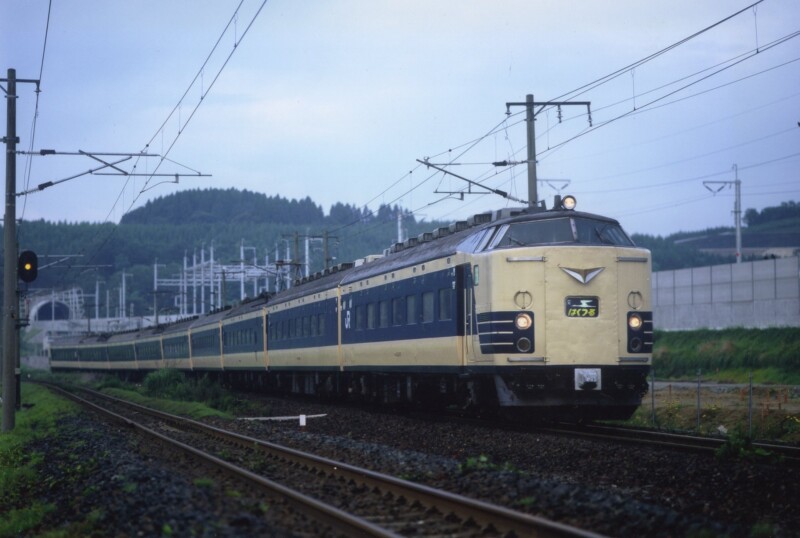
The lyrics were written in the song in the past... Night trains departing from Ueno and heading to Aomori [Aomori Prefecture]
table of contents
- 1 The role played by the night train from Ueno to Aomori
- 2 Night trains from Ueno to Aomori had various routes
- 3 Trains via the Joban Line (via Mito, Taira, and Sendai)
- 4 Trains via the Tohoku Main Line (via Fukushima and Sendai)
- 5 Trains via the Ou Main Line (via Fukushima, Yamagata, Akita)
- 6 After the opening of the Tohoku Shinkansen and Seikan Tunnel
- 7 The last night train from Ueno to Aomori, “Akebono”
- 8 ``Blue Train Akebono'' where you can stay in an actual sleeper passenger car
- 9 summary
I think many of you are familiar with the opening line of Sayuri Ishikawa's single ``Tsugaru Kaikyo Winter View'' released in 1977.
Although it is a famous song that includes scenes of travel in its short lyrics, the `` night train from Ueno to Aomori' ' that appears in this song no longer exists, but rather the Seikan ferry that The service ended earlier than the night train to Aomori.
This time, we will focus on what kind of train the ``night train from Ueno bound for Aomori'' was.
The role played by the night train from Ueno to Aomori

The night train from Ueno to Aomori was created in 1891 during the Meiji era, when the current Tohoku Main Line, the railway from Ueno Station to Aomori Station, was opened.
There has been a direct train from Ueno Station to Aomori Station since its opening, and its operating time at that time was 26 and a half hours, so naturally it was a night train that ran through the night.
In 1977, when "Tsugaru Kaikyo Winter Scenery" was released, the Tohoku Shinkansen had not yet opened, and airfares were expensive. It was common knowledge for the average person at the time that it to travel between Tokyo and Aomori Prefecture by express train
It was wasteful to waste so much time traveling during the day, so there was still considerable demand for night trains that could travel while you were asleep.
the Seikan Tunnel, which runs through the ocean floor of the Tsugaru Strait between Aomori Prefecture and Hokkaido, opened in 1988, so until then, Aomori Station was the northern limit of night train destinations on Honshu. the ``Seikan Ferry'' to transport people crossing from Aomori Station to Hokkaido , and in fact, ``Tsugaru Strait Winter Scenery'' depicts the journey aboard the Seikan Ferry to Hokkaido.
From the opening of the Tohoku Main Line until the opening of the Tohoku Shinkansen and Seikan Tunnel, the night train from Ueno to Aomori continued to connect Kanto, Tohoku, and Hokkaido for many years .
Night trains from Ueno to Aomori had various routes
From here, we will proceed with the story based on the timetable when the famous Goo San Too timetable was revised in October 1978, the year after the release of ``Tsugaru Strait Winter Scenery''. Even though it is simply a night train from Ueno to Aomori, there are various routes along the way, and as of 1978, there were three types.
- After leaving Ueno Station, the train enters the Joban Line and goes to Aomori Station via stations such as Mito, Taira (currently Iwaki), Sendai, and Morioka.
- A train that leaves Ueno Station and heads north on the Tohoku Main Line, passing through stations such as Omiya, Utsunomiya, Fukushima, Sendai, and Morioka, before arriving at Aomori Station.
- The train runs from Ueno Station to Fukushima Station via the Tohoku Main Line, then enters the Ou Main Line and goes to Aomori Station via stations such as Yamagata, Shinjo, Akita, and Odate.
In addition, in later years, trains that went via the Takasaki Line, Joetsu Line, Uetsu Main Line, and Ou Main Line, as well as trains that went through stations such as Omiya, Takasaki, Nagaoka, Sakata, Akita, and Odate, appeared. Masu. From the next section, we will introduce the night trains connecting Ueno and Aomori by route.
Trains via the Joban Line (via Mito, Taira, and Sendai)
The main route for night trains bound for Tohoku was the Joban Line, not the Tohoku Main Line.
In the days before the Tohoku Shinkansen, the Tohoku Main Line, the main artery connecting Kanto and Tohoku, had many trains even during the night hours.
For this reason, night trains that did not need to be very particular about speed tended to go via the Joban Line, although it was a bit of a detour.

Author: spaceaero2 – Author’s own work, CC Attribution 3.0,
by https://commons.wikimedia.org/w/index.php?curid=10649856

Author: spaceaero2 – Photographed by himself, CC Attribution-ShareAlike 3.0,
by https://commons.wikimedia.org/w/index.php?curid=8653434
Among the trains that run on the Joban Line, the first one that should be introduced is ``Yuzuru.'' As of October 1978, a whopping seven trains were operating each day, including three special trains.
Yuzuru No. 1, 3, and 5 used the 583 series train, which could be used both day and night as a sleeping car at night and a seat car during the day (during the day, it was also a limited express train that operated between Ueno Station and Aomori Station). (It was appropriated for "Hatsukari").
were "Blue Trains," which used sleeper cars painted blue
Most of the night trains bound for Aomori were scheduled so that you could transfer to the Seikan Ferry at Aomori Station.
For example, Yuzuru 3 leaves Ueno Station at 19:53 and arrives at Aomori Station at 5:08 the next morning. There, I transferred to the Seikan ferry that departed at 5:25, and arrived at Hakodate Station at 9:15 (the time setting makes me want to take another nap on the ship).
At Hakodate Station, transfer to "Oozora 3" After that, the train split into two at Takikawa Station, arriving at Asahikawa Station at 15:36 and Kushiro Station at 19:41.
It took nearly 18 hours to get from Ueno Station to Sapporo Station, but since trains were the main mode of long-distance travel back then, many people probably used them.
Another night train bound for Aomori via the Joban Line the Towada . On days with the highest number of trains, four trains were in operation, including two special trains. As it is an express train, it stops at more stations than the sleeper express Yuzuru, and each train takes over 12 hours to get from Ueno Station to Aomori Station.
notable feature is that no sleeper cars were attached to the trains other than Towada No. 3, which departed from Ueno Station at 8:50 p.m.
There are no sleeping cars, which means you'll spend 12 hours in your seat overnight. Not only that, some of the seats in the cars had reserved seats, but most of them were unreserved seats. Of course, non-reserved seating meant that there was a chance that the seats would be full when you boarded the train, so during busy periods it was common to lie down on the floor with a newspaper and spend the night there.
Trains via the Tohoku Main Line (via Fukushima and Sendai)
Among the trains that traveled via the Tohoku Main Line, there was one that departed from Ueno Station first among all the "night trains departing from Ueno" (including trains whose destination was not Aomori) at the time.
The first train the Hakkoda . The train departed from Ueno Station at 19:08 and arrived at Aomori Station at 6:17, resulting in a running time of 11 hours. Even after arriving at Aomori Station, the train was not set to allow immediate transfer to the Seikan Ferry, and was intended to be used to access Northern Kanto and Tohoku.
There were no sleeping cars connected to this train either, and all cars except one reserved seat and one green car had non-reserved seats. If you look at it from a modern perspective, you may wonder why trains with such harsh riding conditions existed, but since they are express trains, they are cheaper than limited express trains, and because they are seated cars, they are cheaper than sleeper cars. One advantage was that it was much cheaper than the sleeper express.
It was also a popular train because if you used a ticket called a wide round-trip ticket, you could use a non-reserved seat in Hakkoda. There was only one regular train in Hakkoda per day, but there were up to three special trains per day, and even then it was said to be quite crowded during busy periods.

And then there's the sleeper express "Hakutsuru . Like some Yuzuru trains, the 583 series train was used.
This train only operated once a day. It appears that the main character of the sleeper express bound for Aomori was the Yuzuru, which ran via the Joban Line.
Trains via the Ou Main Line (via Fukushima, Yamagata, Akita)
The first night train to Aomori via the Ou Main Line is the Tsugaru Express There were two trains a day, and Tsugaru 1 also connected with the Seikan Ferry.
In addition to seat cars, including one green car and one reserved seat car, the Tsugaru had three-tier sleeper cars and a more comfortable A-sleeper car. It was said that a person who took a local train from Tohoku to Tokyo to get a job was able to ride in the A berth of the Tsugaru Express train when returning home to Tohoku as a sign of success
I can't forget to introduce the sleeper express ``Akebono.'' All cars on this train were sleeping cars.
In 1978, there were two trains a day, with Akebono No. 1 going to Aomori and No. 3 going to Akita. The 3rd train stopped at Akita, and the 1st train did not connect with the Seikan Ferry at Aomori Station, so it was more of a train connecting Ueno and Akita than a train connecting Ueno and Aomori. may have been strong.
Akebono's route was later changed significantly, but as a result, regular service continued until March 2014, making it the last night train from Ueno to Aomori .
Furthermore, the Ou Main Line, which is the route for these trains, has many stations with strange names for some reason. We have an explanatory article, so please take a look.
After the opening of the Tohoku Shinkansen and Seikan Tunnel
In 1982, the Tohoku Shinkansen opened between Omiya Station and Morioka Station, and in 1985, it opened between Ueno Station and Omiya Station, greatly shortening the travel time between Kanto and Tohoku. However, night trains still had the same advantage of being able to travel while you were sleeping, so night trains were not abolished immediately, but as time progressed, in addition to the Shinkansen, people started using airplanes and express buses. As the number of night trains increased, the number of users of night trains gradually decreased and the number of users gradually declined.
First, in 1985, the Towada Express was downgraded from a regular train to a special train, and later ceased operating as a special train.
Also, in 1988, the Seikan Tunnel opened.
The Seikan Ferry was discontinued as it became possible to travel from Aomori Station to Hakodate Station while remaining on the train. Aomori Station's traditional role as ``the gateway to Hokkaido'' has been lost, and the scene described in those lyrics has become a thing of the past.
After that, the sleeper limited express Yuzuru, express Hakkoda, and express Tsugaru became temporary trains in 1993, and later completely ceased operation. The Hakutsuru Sleeper Limited Express was discontinued in 2002 when the Tohoku Shinkansen line between Morioka Station and Hachinohe Station was extended.
"Hakkoda Maru" that was actually used as the Seikan ferry has been preserved as the "Seikan Ferry Memorial Ship Hakkoda Maru" , a 5-minute walk from Aomori Station

You can go inside the ship (for a fee) and walk on the deck, touch the rudder and communication equipment in the wheelhouse, and see the railway cars on board.
Seikan Ferry Memorial Ship Hakkodamaru < Information >
- Name: Seikan Ferry Memorial Ship Hakkodamaru
- Address: 1-112-15 Yanagawa, Aomori City, Aomori Prefecture
- Phone number: 017-735-8150
- Business hours: 9:00-19:00, admission until 18:00 (April 1st - October 31st)
9:00-17:00, admission until 16:30 (from November 1st) March 31st) - Closed: December 31st, January 1st, Monday to Friday of the second week of March
- Official URL: Seikan Ferry Memorial Ship Hakkodamaru
Google Map
The last night train from Ueno to Aomori, “Akebono”

In the 1990s, construction began to allow Yamagata Shinkansen trains to pass through some sections of the Ou Main Line where the sleeper express Akebono and express Tsugaru were operated. This construction will widen the distance between the two rails to accommodate the Shinkansen, making it impossible for conventional trains to run on it.
For more information on how the Yamagata Shinkansen (Shinkansen Tsubasa) was born, please see this article.
Akebonoya Tsugaru, which was no longer able to operate on its previous route, continued to operate after changing its route in 1990. However, Tsugaru was changed to a temporary train in 1993, shortly after the route was changed to the Tohoku Main Line, Senzan Line (which connects Sendai Station and Uzen-Chitose Station in Yamagata Prefecture), and Ou Main Line, and its operation ended. I'm heading to.
At that time, two trains a day were running on the Akebono line, one of which was changed to the Tohoku Main Line, Rikuu Higashi Line (the line connecting Kogoda Station in Miyagi Prefecture and Shinjo Station in Yamagata Prefecture), and the Ou Main Line.
The other train was changed to go via lines such as the Takasaki Line, Joetsu Line, and Uetsu Main Line, in other words, it went through Gunma Prefecture, Niigata Prefecture, and Yamagata Prefecture on the Sea of Japan side, and the train name was changed to ``Chokai''. ” was changed to.
In 1997, Akebono's route was changed to the same route as Chokai, that is, passing through the Sea of Japan, and Chokai disappeared. There are no parallel Shinkansen lines along the Sea of Japan coast from Niigata Prefecture to Aomori Prefecture.
Perhaps for that reason, Akebono continued to exist for a relatively long time after that, and during that time all the night trains that once headed for Aomori Station disappeared.
Akebono will inevitably face problems such as competition with other transportation systems and aging vehicles, and the time will finally come for it to end.
Regular service of Akebono ended with the train departing on March 14, 2014. It last operated as a special train at the beginning of 2015, and has not operated at all since then.
The ``night train from Ueno to Aomori,'' which has been running since the Tohoku Main Line was completed in 1891, has finally come to an end after a long history spanning more than 120 years .
``Blue Train Akebono'' where you can stay in an actual sleeper passenger car

as , has been opened on the premises of ``Kosaka Railway Rail Park'' in Kosaka-cho, Kazuno-gun, Akita Prefecture. It is one of the rare facilities where you can stay overnight in a private berth on the Blue Train, which has now completely disappeared.
The Kosaka Railway Rail Park is a railway complex that utilizes the tracks, equipment, and vehicles of the Kosaka Railway, which was abolished in 2009. This place has a nostalgic atmosphere and a history that can be enjoyed by both adults and children.
Blue Train Akebono<Information>
- Name: Blue Train Akebono
- Location: 20-9 Furukawa, Kosaka Mine, Kosaka-machi, Kazuno-gun, Akita Prefecture
- Phone number: 0186-25-8890
- Available dates: Please check on the website, closed in winter
- Official URL: Blue Train Akebono
Google Map
summary
As you can see, back in the days when ``Tsugaru Straits - Winter Scenery'' became a hit, night trains from Ueno to Aomori were a
`commonplace I don't think many people could have predicted that not a single one would be left.
It's a bit of a sad story, but some of the things we now take for granted (not just railways) will eventually disappear.
However, it is also true that even if the train disappears, the memories of riding that train remain in the hearts of many people, including myself.
We would like our readers to experience a memorable trip unique to this era.







![What is Seikan Ferry? Eight decades of supporting the human flow and logistics between Honshu and Hokkaido [Aomori Prefecture] 23246977_m](https://jp.neft.asia/wp-content/uploads/2025/05/23246977_m-150x150.jpg)
![Two years have passed since the heavy rains in August 2022... what will happen to the Tsugaru Line? [Aomori Prefecture] 29844953_m](https://jp.neft.asia/wp-content/uploads/2024/07/29844953_m-150x150.jpg)
![Cars and bicycles are not accepted! Staircase National Route 339 [Aomori Prefecture] 7980_Ryutoizaki Staircase National Highway (Tappizaki Kaidankokudo)](https://jp.neft.asia/wp-content/uploads/2024/11/0c633264db24b0066af3a9574a57a5e3-150x150.jpg)
![I read the picture book "I Got on the Train" [Aomori Prefecture] Mashumaru](https://jp.neft.asia/wp-content/uploads/2025/08/2244492_s-150x150.jpg)

![[Shimokita Peninsula, Aomori Prefecture] Geopark Shimokita Peninsula. A rich hot spring springs from the northernmost peninsula of Honshu 24734759_m](https://jp.neft.asia/wp-content/uploads/2023/02/24734759_m-150x150.jpg)

![The mysterious world of the Shimokita Peninsula of Geopark: "The northern limit of monkeys on Osoreyama and Butsugaura" [Aomori Prefecture] 25110883_m](https://jp.neft.asia/wp-content/uploads/2022/11/25110883_m-150x150.jpg)











